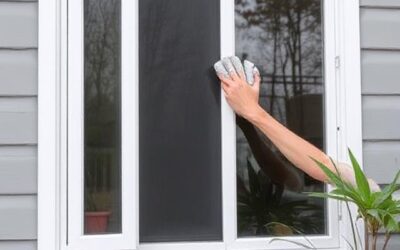How to tint home windows? 8 Easy Steps
We see a lot of customers that have tried or thought about how to tint home windows. Some do a decent job installing their own, while others look pretty bad. A more significant concern is that sometimes they will install a film that is unsafe for their windows and could cause them to break. We want to go through the residential window tinting process step-by-step to see if it is something you want to do while avoiding some of the common mistakes or if you prefer to hire a trained professional.
Step 1: Film Selection
The first step for house window tinting is choosing the best window film for you. You want a window film that will achieve your goals and is safe for your window type. First, ask yourself what you are trying to accomplish with residential window tinting. Do you want to block heat, gain privacy, reduce glare, etc.? Also, how dark do you want to go? Do some research online or ask a local shop what type of window film will best achieve your desired goals. Once you know this, you can purchase the window film online, at a hardware store, or from a local shop.

What film is safe for your windows? Most glass types are either annealed, tempered, heat-strengthened, or laminated. Annealed is the most common type. You need to be careful with annealed glass because installing a window film that absorbs too much heat can break the glass. You can install most any type of window film with tempered and heat-strengthened glass. You can identify this type of glass by a logo in the corner that will state tempered or heat-strengthened. These windows are usually doors or windows close to doors, sinks, stairs, rails, or low to the ground. Laminated glass is rare in homes, except for with skylights. Almost no film is safe to install on laminated glass.
Some home windows are single-pane windows, meaning they only have one pane of glass, but many are double-pane windows with two panes of glass. In places like Colorado, most windows are double-pane windows with annealed glass. You need to ensure you install an approved film for this glass type. The easiest way to do this is to check with the manufacturer or a local shop. You want a film with enough reflectivity to absorb little heat rather than only absorbing it. Professional residential window tint providers are certified by the manufacturers to know which window tints are safe to use on your glass. The window tint manufacturers extend a glass breakage warrant to their customers.
Step 2: Tools
After you have found the best house window tint to achieve your goals, you are ready to gather the tools for your installation. You will use some tools in multiple steps when installing your residential window tint. In the following steps, we will examine how to use each tool in more detail. First, you will need a spray bottle filled with water and a little dish soap or baby shampoo. You will use this during the cleaning process and the installation of your residential window film. You will want towels to keep the water from pooling on the window frame or floor. You will also need a good, lint-free paper towel. Other items that may help with your specific application are a stool, ladder, or scaffold.
For the cleaning process, you will need a scraper with a stainless steel blade. Using stainless steel blades throughout the house window tinting process is vital to avoid scratching your windows. We usually use a 6″ glass scraper. Some glass doesn’t allow you to use a scraper blade; you will want a white scrub pad for these. Sometimes we also use a toothbrush to help clean dirty window frames. Finally, for the cleaning portion, you will want a cleaning squeegee. A cleaning squeegee usually has a handle that attaches to a metal channel holding a black rubber squeegee.
While installing your home window tinting, you will want an installation squeegee, a hard card, and a cutting knife (also stainless steel). The installation squeegee is similar to the cleaning squeegee, but the blade is usually firmer than the cleaning rubber. A hard card can come in different forms, but it is usually a plastic card that allows you to push more water out from under the film and assist in cutting the film.
Step 3: Preparation
Now you are ready to prepare for your window film installation. At this point, you will lay out any towels or blankets to catch the water you will be using and remove anything in your way, including blinds. Then, you will precut the window film so that it is about 1″ larger than the actual glass size of your window.
Step 4: Clean the window
Cleaning the glass is the most critical part of residential window tinting. For the cleanest installation possible, your glass and frames must be completely free of dirt and dust. To clean the window, you will spray the window with your soap and water solution and then use your cleaning scraper to scrape every part of the glass. Remember, not all glass allows you to use even a glass-safe scraper; if you think you are scratching the glass or your scraper blade makes a gritty sound, you need to stop and use the white cleaning scrub pad to scrub every inch of your glass thoroughly. Next, you will respray your window and use your cleaning squeegee to take all of the water down to the bottom of your window. Finally, you will use a lint-free paper towel to wipe the frames, removing as much dirt as possible from them and soaking up any extra water. If you feel your window frames are still dirty, you can use a toothbrush to scrub the frames where they meet the glass before wiping them with your paper towel.
Step 5: Placing the film and the first squeegee
Now you are ready to install your first piece of house window tint. The window film will have a thin clear liner that protects the film’s adhesive. You will remove this liner just like you would remove the back of a sticker before placing a sticker. Once you remove the release liner, spray both the film’s back and the glass, allowing you to move the film on the glass and cover all four edges before the adhesive sticks. For large windows, roll the film up and only remove a small portion of the liner as you place it on the window.
Once the film is in the position that you want, spray the outside of the film so that your installation squeegee will glide over the film. Use your installation squeegee with overlapping strokes to push as much of the water out between the film and the glass toward the edge of the window. Don’t push the water to the edge; keep about an inch away; you will get the remainder out in Step 7.
Step 6: Cutting
Cutting the film is easy once you know what you are doing. First, you will use your hard card to push the film into the corners. Then, starting in one corner, you will use the hard card to hold the house window film down, placing it between your stainless steel cutting blade and the window frame. Move the card along with your knife blade as you cut along the entire edge of the window frame. Repeat this process for the other three window frames.
Step 7: Final Squeegee
Now you can do a final squeegee to get any remaining moisture out, along with the water you left at the edge of the window in Step 5. We recommend wrapping your hard card in a lint-free paper towel for the final squeegee to keep your card from scratching your film and soaking up any water once you reach the edge of the window, preventing it from sucking back under the film. You may need to adjust your paper towel several times to have a nice dry piece against the glass with each overlapping squeegee pass.

Step 8: Cleaning up, Care and Maintenance
Now you have installed your first piece of residential window film. Use a soft cloth to remove any extra water from the film and the window frame. There will still be moisture trapped underneath the window film; this is normal. Most window films have a 30-day curing period where the remaining moisture may bead up and evaporate out through the film. During this period, you may see moisture bubbles and haziness.
Using abrasive materials or ammonia when cleaning your window film is not good. We recommend using any ammonia-free glass cleaner and a microfiber cloth.
Conclusion
Now that you have a detailed outline of the steps required to tint your windows, you can decide if this is something you want to try on your own or would prefer to hire a trained professional. Look up “home window tinting near me” online to find a local professional near you. Using a local shop will help ensure an excellent installation. Most residential window tinting companies will do free estimates.
Get in touch with Columbine Window tint!











